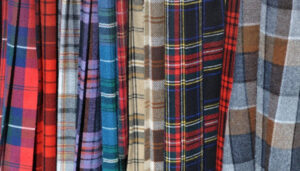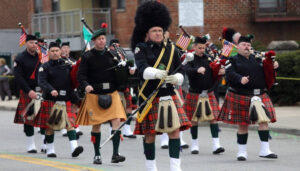Traditional Scottish Tartan
Tartan is a patterned cloth consisting of crisscrossed, horizontal, and vertical bands in multiple colors, forming simple or complex rectangular patterns, originated in woven acrylic wool, but is now made in other materials. The earliest evidence of tartan in Scotland was found in Falkirk, buried in a pottery jar, which dates back to 250 AD, however, it is unclear when they originated. It is believed the material was not commonplace until the 16th century when highlanders wore it to identify different Scottish clans. Initially, it was dyed using natural dyes from native plants and usually found in only two or three colors, but with the development of chemical dyes, they can be found in a larger variety of colors. Traditional patterns were created using natural dyes, often in shades of green and blue.
Transformation of Tartan into Kilt
The transformation of tartan into the kilt is a fascinating evolution of Scottish attire. Originating as the “feileadh mor,” or belted plaid, in the late 16th century, as we know it today emerged in the 18th century, initially simple checks of one or two colors, evolved to represent different Scottish clans, adding a sense of identity and pride to the garment. Over time, Kilt became a symbol of Scottish allegiance, rebellion, and later, a national symbol of Scotland, its design and association with their identity have continued to evolve, making it a recognizable and controversial icon.
Tartan Patterns and Thread Count:
The significance of thread count in tartan patterns is paramount, as it serves as the fundamental determinant of the pattern’s design, size, and complexity. By specifying the number of threads for each color in the warp and weft, the thread count produces a unique arrangement of colored stripes, which gives each of them its distinct identity. Whether creating symmetrical or asymmetrical patterns, the thread count plays a pivotal role in influencing the fabric’s color variations and overall look. Furthermore, they hold historical and cultural significance, with each thread count representing a unique design that carries specific meanings. For example, the Royal Stewart Tartan, associated with the British royal family, features a bold red and green plaid pattern, reflecting its historical importance. In essence, the thread count is an essential element that encapsulates the intricacies of its design and its rich cultural heritage.
The line “B24 W4 B24 R2 K24 G24 W2” represents the DNA of a tartan, illustrating its intricate design and historical importance. This specific arrangement of threads signifies:
- 24 threads of blue
- 4 threads of white
- 24 threads of blue
- 2 threads of red
- 24 threads of black
- 24 threads of green
- 2 threads of white
Tartan DNA encapsulates the design’s complexity and historical significance, serving as a unique identifier for a particular one.
Introduction to Traditional Tartan Colors
Tartan is a patterned cloth consisting of criss-crossed, horizontal, and vertical bands in multiple colors, forming simple or complex rectangular patterns. They originated in woven acrylic wool but are now made in other materials, particularly associated with Scotland, and Scottish kilts almost always have tartan patterns. The use of natural dyes in early patterns and the evolution of tartan colors over time have contributed to the significance of kilt colors in Scottish culture and history. There is no set of exact color standards for tartan hues, but a certain range of general colors are traditional in them, including blue, crimson, green, black, and grey. They have now gained international popularity with people selecting tartan for their clothing and accessories.
Origins of Kilt Color Symbolism
The origins of kilt color symbolism trace back through the annals of Scottish history, reflecting centuries of Celtic customs and traditions. Tartan, the iconic pattern of the kilt, evolved from simple checks of one or two colors, with dyes derived from local plants, roots, berries, and trees. This unique pattern later became a symbol of Clan identity, with each color representing specific meanings such as a parent clan, an occasion, or a traditional style. The kilt, once confined to the Highlands, has now become a global symbol of Scottish culture and heritage, worn with pride and honor as a tribute to tradition and national identity.
Clan Color Identity and Ancestry:
Clan color identity and ancestry are intertwined, as kilt colors can represent a parent clan and provide a link to one’s ancestry. Wearing a clan’s colors can connect individuals to their heritage, whether at family events or other gatherings. Here are some key points to consider:
- Kilt colors represent a parent clan: Each clan has its unique tartan, made up of a specific combination of colors and patterns, which are often passed down from generation to generation with pride.
- Connection to ancestry: Wearing a clan’s colors can provide a sense of identity and connection to one’s ancestors, as the tartans have been passed down through the years and are often associated with specific families or clans.
- Kilt colors in military regiments: In the past, kilt colors played a role in military regiments, helping to identify members of a particular clan on the battlefield.
- Kilt colors for special occasions: Kilt colors are often chosen for weddings and other significant events, adding a touch of tradition and symbolism to the occasion.
- Cultural significance: Both Scottish and Irish kilts are important symbols of cultural heritage and identity, with different patterns representing specific clans, families, or counties.
In summary, the colors of a kilt can represent a parent clan and provide a link to one’s ancestry, connecting individuals to their heritage and cultural roots. These colors play a significant role in various aspects of life, from military regiments to special occasions, and serve as a powerful symbol of identity and connection to the past.
Ancient, Modern, and Reproduction Tartans:
They are a rich part of Scottish culture, with various color palettes and styles. Here’s a brief overview of the different types of tartans and their historical significance:

Ancient Tartans: With their lighter, softer colors, aim to replicate the enchanting hues of plant-derived dyes predating Victorian chemical dyes. These colors, assumed to be lighter in historical tartans, capture a delicacy that transforms:
- fiery red into light orange,
- deep blue into a gentle sky blue,
- lush green into a lively grassy green,
- and radiant yellow into a subtle pale yellow.
The Ancient palette, popularized in the 1950s and ’60s, offers a more historically authentic and softer look, evoking a sense of material worn beyond its years.
Modern Tartans: A reflection of the luxurious and bold nature of 19th-century chemical dyes. They employ a standard color palette that emulates the modern chemical dyes invented in the 19th century. The colors are bright and vibrant, resembling a primary color wheel.
- Bold red commands attention from a dim red,
- while navy blue exudes depth from a simple blue,
- dark bottle green evokes ancient forests, contrasting with dull grassy green,
- vivid yellow radiates energy in comparison to a pale shade.
The Modern palette is widely considered to be the standard for Scottish tartans, embodying the epitome of their evolution.
Muted Tartans: A contemporary concept that captures soft and natural tones, positioned between the lightness of ancient and the opulence of modern color palettes. The palette represents a unique spectrum in the realm of colors, blending the lightness from the ancient color palette with the opulence of the modern palette. The concept embraces a contemporary aesthetic with its muted tones, offering a visually appealing combination of colors for various applications.
- The rich red resembling the color of blood,
- stormy sky blue evoking a sense of mystery,
- olive green reminiscent of tranquil landscapes,
- and golden shade reminiscent of precious metals.
These are some of the colors that make up the muted palette.
Weathered Tartans: The “Weathered” color palette, also known as “Reproduction,” captures the timeless charm of tartans that have endured the elements. It includes:
- “Salmon” red, reminiscent of twilight hues,
- “Bluish grey” evoking stormy skies,
- “Green” transforming into earthy brown,
- and “Pale gold” resembling sun-kissed fields.
This palette aims to connect with historical fibers, exuding a timeless quality and enduring beauty despite exposure to the elements. Each color is associated with specific atmospheric elements, adding depth and storytelling to the overall design.
Hunting Tartans: A variation of the traditional bright red tartans, were developed for Clansmen during hunting expeditions.
- These tartans feature darker, natural colors like greens, browns, and blues, meticulously chosen to blend with the Highland countryside during hunting.
Each of them is a work of art, reflecting the beauty of the Scottish landscape and serving as a timeless symbol of tradition and heritage. The unique plaids of hunting tartans evoke the rugged beauty of the Scottish countryside, making them an essential part of Scottish cultural heritage.
Modern Interpretations of Kilt Colors:
The influence of contemporary fashion on tartan designs has led to the emergence of new and unique kilt colors, reflecting a blend of tradition and modernity. Tartan color palettes, such as Ancient, Modern, Muted, and Weathered, offer a wide range of options for kilt enthusiasts. The Modern color palette features bold and vivid shades, representing the standard for Scottish tartans, while the Ancient palette simulates older plant-derived dyes with lighter tones. Muted and Weathered palettes embrace soft, natural colors, inspired by contemporary concepts and the effects of weathering on kilts. These interpretations showcase the evolution of their designs, allowing individuals to express their personal style while honoring tradition and heritage.
Color Meanings in Irish Kilts:
Irish kilts are a proud Irish custom, and the colors used in them have significant meanings. The Saffron kilt, for instance, is mustard yellow and often features shamrock appliques, representing the Irish heritage and culture. Green is another popular color for solid-colored Irish kilts, symbolizing the lush green landscape of Ireland. The colors of tartan used in Irish kilts are said to represent the natural landscape and history of the county, with blue and green representing the sea and land, respectively. Muted shades of browns, greens, and reds are also used in Irish county designs, giving them an earthy quality. The meanings behind these colors reflect the uniqueness and history of Celtic culture, making Irish kilts a symbol of pride and celebration.

Wearing Kilt Colors for Non-Scottish Individuals:
Wearing a kilt is not offensive for non-Scottish individuals, as long as it is worn for a legitimate reason. Kilts are a traditional form of men’s clothing in Scotland and are often worn on special occasions. However, people of Scottish heritage in the United States are free to express their cultural identity in any way, including through clothing or other means. When choosing a pattern, it is important to be aware of the tartan’s significance, as some of them are specific to certain families or clans. For non-Scottish wearers, it is recommended to choose a universal one, such as the Black Watch tartan, which has a military history and is easily worn by most people. Ultimately, the decision to wear a kilt or not should be based on personal preferences and respect for the cultural significance of the garment.
Choosing the Perfect Tartan for Your Kilt:
When choosing, consider factors such as personal preference, clan affiliation, and event type. If you have a Scottish surname, you can start by checking if it’s associated with a specific tartan. However, if your surname has no tartan, you have the freedom to choose any you like. Additionally, consider the event for which you’ll be wearing the kilt and whether you prefer a modern, ancient, weathered, hunting, or dress tartan. Ultimately, the most important thing is to choose that you personally like and that reflects your style and identity. Whether it’s a clan or a universal one, wear it with pride and honor.
Looking to buy a Custom Tartan Kilt?
Looking to buy a Tartan Kilt? Look no further than Fashion Kilt! Our made-to-measure options ensure a perfect fit, providing both comfort and confidence. While our standard delivery takes weeks, our rush service guarantees your kilt will be in your hands within one week to days without compromising quality. At Fashion Kilt, customer satisfaction is our top priority. We stand firmly behind our product quality, and any inconvenience experienced on your end is covered by our comprehensive money-back guarantee. We understand that peace of mind is just as important as the enduring legacy of tartans. Trust Fashion Kilt to provide you with a high-quality, custom-made tartan kilt that you’ll love wearing for years to come.
FAQs
Why Do Scots Wear Kilts?
The kilt is the national dress of Scotland and is worn by many as a symbol of honor for the clan they belong to. It was first worn by those who lived in the Scottish Highlands and was a manner of dress that afforded the fighting army possibly its most useful tool. The kilt allowed those who wore it to move much more freely, especially in the Highlands of Scotland where the weather can become very damp.
Why are certain colors used in Scottish tartans?
The colors used were often dependent on the natural dyes available. For instance, green symbolizes the forest, blue symbolizes lakes and rivers, and yellow represents crops.
What Tartan Does The U.S. Military Use?
The U.S. Military uses the Edzell Tartan, which was first produced in 1985 to recognize the close cooperation between the US military and the local civilian community. The colors in it represent inter-service cooperation by their use in the design: Dark Blue for the US Navy, Light Blue for the US Air Force, Red for the US Marine Corps and US Army, and White for the waves of the oceans.
What Tartans Are Worn at the Highland Games?
They worn at the Highland Games are typically associated with specific Scottish clans and families, reflecting their unique heritage and history. During the games, participants and attendees often display their clan’s tartan through kilts, sashes, or other accessories, adding a colorful and meaningful aspect to the event. The Parade of Tartans at the Grandfather Mountain Highland Games, for example, provides clans and societies with the opportunity to showcase their distinctive, contributing to the vibrant and authentic atmosphere of the gathering.
Does Tartan Differ by Gender?
They do not inherently differ by gender. Both men and women can wear tartan kilts, and there are no specific tartans exclusively designated for a particular gender. In recent times, women have been wearing kilts tailored for men, and traditional men’s kilts typically have the apron fastened on the right side, while women’s kilts often feature left-side fastening.
What are the Oldest Tartans?
The oldest of them date back to the Bronze Age, with remnants found in ancient burial sites like the Falkirk Tartan. However, the most renowned is the “Ferintosh” tartan, believed to have originated in the 3rd century. These historic patterns provide a timeless connection to Scotland’s rich cultural heritage.
Do kilt colors have specific meanings?
Yes, kilt colors have specific meanings. For instance, red tartan was said to be worn in battle to conceal blood, while green, blue, and yellow have religious significance, representing Catholics and Protestants.
Are there any restrictions on wearing specific tartans?
The Balmoral tartan is an exception and is worn by the Royal Family. Permission is required to wear it. However, apart from this, as long as one is respectful, they can wear almost any of them regardless of their heritage.
What are the most common colors found in Scottish tartans?
The most common colors found in them are red, green, blue, and yellow. These colors have historical and religious significance and are widely used.
What are the most popular kilt colors?
The most popular kilt colors include the Royal Stewart (red, green, blue), Black Watch (black, blue, green), and Mackenzie (blue, green, red). These are widely recognized and commonly used for kilts, reflecting a mix of traditional Scottish hues. Red, green, blue, and black are common colors found in many popular kilt designs, each with its own symbolic and cultural significance.


